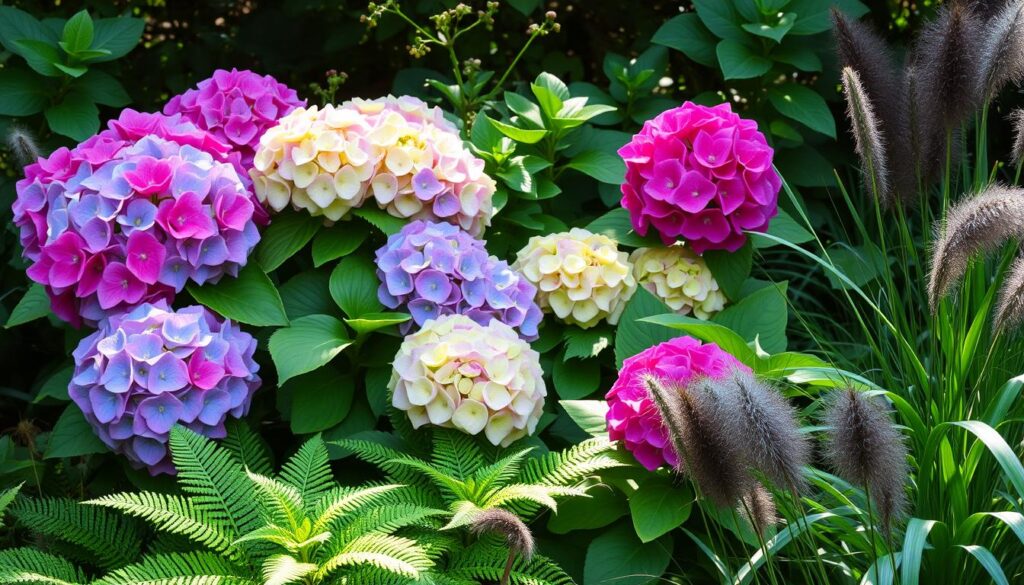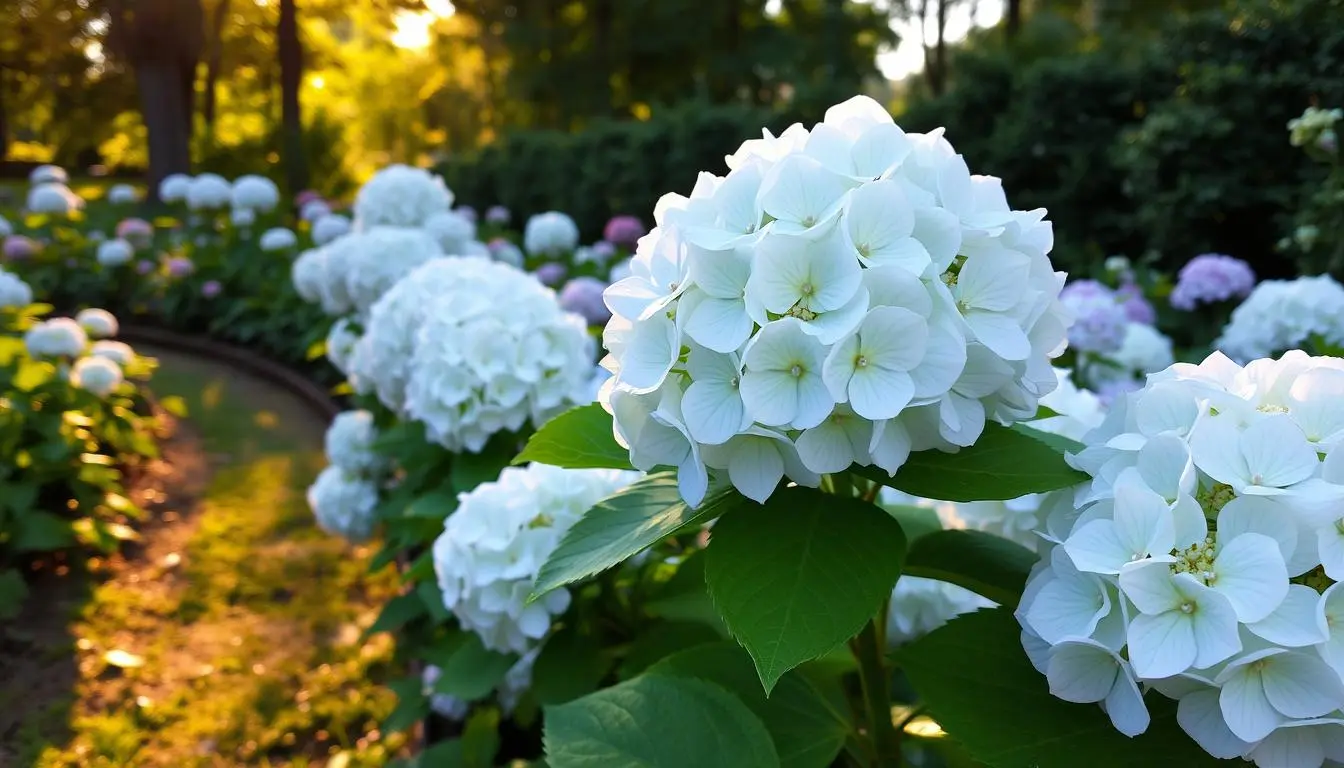The sun shines through the leaves, and the smooth hydrangea blooms light up the garden. This beautiful shrub is a favorite in American gardens. It’s loved for its easy care and stunning looks.
Whether you’re new to gardening or have years of experience, the smooth hydrangea will enchant you. It turns any outdoor space into a peaceful oasis.
In this guide, we’ll explore the smooth hydrangea’s world. We’ll look at its home, special features, and top varieties for your garden. You’ll learn how to pick the best spot, prepare the soil, and plant your hydrangea right.
We’ll also share tips on watering, pruning, and solving common problems. This will help you become a pro at growing smooth hydrangea.
Table of Contents
Understanding Smooth Hydrangea (Hydrangea arborescens)
Smooth hydrangea, known as Hydrangea arborescens, is a favorite among gardeners in the U.S. It comes from the eastern parts of North America. This hardy shrub is perfect for many gardens, bringing natural beauty outside.
Native Habitat and Natural Growth Patterns
Smooth hydrangea grows wild in moist, shaded spots like woodlands and stream banks. It can grow 3 to 6 feet tall, with a similar spread. Its strong stems and large leaves support its beautiful flowers.
Distinctive Features and Characteristics
The smooth hydrangea’s big, rounded flower clusters are called panicles. These can be creamy white or soft pink, depending on the soil. The flowers last for weeks in summer, adding color to gardens.
Popular Varieties and Cultivars
The Annabelle hydrangea and Incrediball smooth hydrangea are favorites. The Annabelle has huge, white flowers up to 12 inches wide. The Incrediball has even bigger blooms, perfect for garden beds.
“Smooth hydrangeas are a true garden staple, providing a beautiful, low-maintenance addition to any landscape.”
Whether you like the classic Annabelle or the big Incrediball, smooth hydrangeas are great. They add elegance to any outdoor space.
Selecting the Perfect Location for Your Smooth Hydrangea
Choosing the right spot for your smooth hydrangeas is key to their success. These beautiful shrubs need specific conditions to thrive. Knowing the best location for your hydrangea is crucial for a vibrant garden.
Sun exposure is a major factor. Smooth hydrangeas do well in partial shade to full sun, depending on your area’s climate. In hot climates, they need some afternoon shade to avoid wilting. But in cooler areas, they can handle more sunlight.
The soil conditions are also vital. They love moist, well-drained soil that’s rich in organic matter. Stay away from areas with poor drainage or heavy clay soil to prevent root rot. Instead, pick a spot where they can spread and grow fully.
Look for a spot that balances sun exposure and soil conditions for your hydrangeas. By picking the right spot, your hydrangeas will thrive. They’ll become the highlight of your outdoor space.
Soil Requirements and Preparation Techniques
For lush, vibrant smooth hydrangeas, soil matters a lot. Knowing the best soil conditions is key for your plants to thrive.
pH Levels and Soil Amendments
Smooth hydrangeas love slightly acidic soil, with a pH of 5.5 to 6.5. If your soil is too alkaline, add sulfur or aluminum sulfate to lower it. For too acidic soil, lime or wood ash can raise the pH.
Drainage Considerations
Good drainage is vital for smooth hydrangeas to avoid waterlogging and root rot. Test your soil’s drainage by digging a hole and seeing how fast water drains. If water stays too long, improve drainage with organic matter or raised beds.
Organic Matter Integration
- Add lots of compost, aged manure, or other organic stuff to the soil. It makes the soil better and adds nutrients.
- Organic matter keeps moisture, improves air, and gives vital nutrients for growth.
- Try to mix 2-4 inches of organic matter into the top 8-12 inches of soil before planting.
Right soil conditions mean your smooth hydrangea will grow well and beautify your garden.
“Proper soil preparation is the foundation for growing healthy and thriving smooth hydrangeas.”
Planting Your Smooth Hydrangea Successfully
Planting your smooth hydrangea right is key to its health and beauty. Whether it’s a new plant or a transplant, follow these steps for success. This will help your smooth hydrangea grow well in your garden.
Preparing the Planting Hole
Begin by digging a hole that’s twice as wide as the root ball and just as deep. This lets the roots spread and grow strong. Loosen the hole’s sides to help the roots grow outward.
Positioning the Plant
Put the smooth hydrangea in the hole, making sure the root ball is level. Fill the hole with the original soil. Don’t add too much, as smooth hydrangeas like well-draining, slightly acidic soil.
Initial Care and Watering
Water the plant well after planting to settle the soil. Keep watering about 1 inch per week until it’s established. This usually takes the first growing season.

By using these planting smooth hydrangea tips, you’ll set your plant up for success. Enjoy a lifetime of hydrangea planting joy in your garden.
Essential Watering and Moisture Management
Keeping the right moisture level is key for your smooth hydrangea’s health. It’s vital to have a watering plan that changes with the seasons.
Watering Schedule Throughout Seasons
In spring and summer, when your hydrangea grows fast, water it often. Make sure the soil is moist but not too wet. Try to give it about 1 inch of water each week, from rain or extra watering.
When fall comes, water less to help your plant get ready for sleep. In winter, water just a little to keep the roots from drying out.
Mulching Methods for Moisture Retention
Putting organic mulch around your hydrangea helps keep moisture in. Mulching techniques like shredded bark or wood chips help the soil stay moist and stop weeds.
Keep the mulch 2-4 inches thick, but don’t let it touch the plant. Refresh it often to keep it working well all season.
“Proper watering and mulching are essential for the long-term health and beauty of your smooth hydrangea.”
Pruning and Maintenance Guidelines
Proper pruning and maintenance are key for your smooth hydrangea’s health and blooms. Follow these tips to keep your plant thriving and beautiful.
Timing is Key
The best time to prune your smooth hydrangea is in late winter or early spring. This lets the plant focus on new growth and blooms.
Pruning Techniques
- Use clean, sharp pruning shears for clean cuts just above an outward-facing bud or leaf node.
- Remove dead, damaged, or crossing stems for better air and light.
- Thin the center to encourage new growth and a balanced shape.
Remember, the goal is to shape the plant without drastically reducing its size. Aim for a light, selective pruning approach to preserve the plant’s natural charm.
Ongoing Maintenance
- Regularly check your smooth hydrangea and remove dead, damaged, or diseased foliage.
- Apply a balanced, slow-release fertilizer in early spring for healthy growth.
- Mulch around the base to keep moisture in and weeds out.
“Proper pruning and maintenance are the keys to unlocking the full potential of your smooth hydrangea. With a little care, you can enjoy years of vibrant blooms and lush foliage in your garden.”
By following these guidelines, your smooth hydrangea will thrive. Remember, timing, technique, and ongoing care are the secrets to success.
Common Problems and Solutions for Smooth Hydrangea Care
Smooth hydrangeas are beautiful and hardy, but they can face common issues. It’s important to know these problems and how to solve them. This way, you can keep your smooth hydrangea garden healthy and vibrant.
Disease Prevention and Treatment
Smooth hydrangeas can get diseases like powdery mildew. This fungal infection makes leaves and stems white and powdery. To stop it, make sure plants have good air flow. Also, use fungicides when you first see the disease.
Pest Management Strategies
Smooth hydrangeas can attract pests like aphids, spider mites, and leaf-feeding beetles. These pests can harm the plant. To control them, try handpicking, using horticultural oils, or introducing beneficial insects.
Environmental Stress Factors
Smooth hydrangeas can also face environmental stress. Things like extreme temperatures, drought, or too much moisture can be a problem. Choose the right spot for your plants, water them regularly, and use mulch. This helps them grow well.
Knowing about common problems with smooth hydrangeas and how to fix them is key. With the right care, you can enjoy their beautiful blooms and lush foliage for many years.
Companion Planting and Landscape Design
Creating a stunning garden with smooth hydrangeas starts with the right companion plants. These plants enhance the hydrangeas’ beauty and grow well together. This makes for a beautiful and balanced landscape design.
Astilbes are a great match for smooth hydrangeas. Their feathery plumes add elegance and contrast. Azaleas and begonias bring color and texture to the garden. Ornamental grasses, boxwood, and coral bells create lush ground covers and low-growing accents.
- Geraniums, daylilies, and flowering dogwood trees offer plenty of blooms to match the hydrangeas.
- Foxglove, hakone grass, and hostas love the partial shade hydrangeas prefer, making for a beautiful garden.
- Japanese maple trees, ferns, and Japanese pieris add depth and interest all year round.
“The right companion plants can transform a hydrangea-centric garden into a true oasis of beauty and harmony.”
Choosing the right companion plants for smooth hydrangeas can make your garden lush and stunning. It showcases the beauty of these shrubs and improves your landscape design.

Seasonal Care Tips for Healthy Growth
To keep your smooth hydrangeas healthy and beautiful, you need to know their seasonal needs. Each time of year has its own care routine. This ensures your hydrangeas grow well and look great in your garden.
Spring Care Routines
In spring, your smooth hydrangeas need some extra care. Start by removing winter protection and mulch. This lets the soil warm up and promotes new growth.
Next, prune dead or damaged stems. Cut just above a healthy bud. Finally, use a balanced fertilizer to feed them for the growing season.
Summer Maintenance
In summer, keep your hydrangeas watered. They love moist, well-drained soil. Water them about 1 inch per week, either from rain or irrigation.
Also, remove spent flowers to keep them blooming. Mulch around the plants to keep the soil moist and control weeds.
Winter Protection Methods
When fall comes, prepare your hydrangeas for winter. Seasonal care for smooth hydrangea is key during this time. Start by cutting stems to about 12 inches above the ground.
Then, add a 4-6 inch layer of mulch around the plant. Be careful not to cover the crown. This winter protection for hydrangeas keeps the roots warm and prevents frost damage.
By following these seasonal care tips, your smooth hydrangeas will stay healthy and vibrant all year. They’ll be a beautiful highlight in your garden.
“The secret to growing healthy hydrangeas is understanding their seasonal needs and providing the right care at the right time.”
Conclusion
Growing smooth hydrangeas can be very rewarding. By understanding their unique traits, choosing the right spot, and giving them the right care, you can create a beautiful hydrangea garden beauty. This will make your garden a joy to behold for years.
This guide has given you the tools to grow smooth hydrangeas successfully. You now know how to handle the soil and prune them correctly. Remember, stay alert to any issues and adjust your care as needed for your plants.
Keep exploring your gardening path with smooth hydrangeas. They can be the stars of your garden, adding beauty and charm. Whether they’re the main attraction or part of a larger design, they will surely impress and bring happiness to your outdoor space.

